
Market Square (Lviv)
Encyclopedia
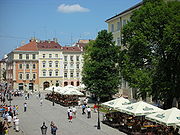

Lviv
Lviv is a city in western Ukraine. The city is regarded as one of the main cultural centres of today's Ukraine and historically has also been a major Polish and Jewish cultural center, as Poles and Jews were the two main ethnicities of the city until the outbreak of World War II and the following...
, Ukraine
Ukraine
Ukraine is a country in Eastern Europe. It has an area of 603,628 km², making it the second largest contiguous country on the European continent, after Russia...
. It was planned in the second half of the 14th century, following granting city rights
Magdeburg rights
Magdeburg Rights or Magdeburg Law were a set of German town laws regulating the degree of internal autonomy within cities and villages granted by a local ruler. Modelled and named after the laws of the German city of Magdeburg and developed during many centuries of the Holy Roman Empire, it was...
by Polish king Casimir III
Casimir III of Poland
Casimir III the Great , last King of Poland from the Piast dynasty , was the son of King Władysław I the Elbow-high and Hedwig of Kalisz.-Biography:...
, who annexed Red Ruthenia
Red Ruthenia
Red Ruthenia is the name used since medieval times to refer to the area known as Eastern Galicia prior to World War I; first mentioned in Polish historic chronicles in the 1321, as Ruthenia Rubra or Ruthenian Voivodeship .Ethnographers explain that the term was applied from the...
. The king ordered Lviv to be moved more to the south, where a new city was built to the plan of a traditional European settlement: a central square surrounded by living quarters and fortifications. Old, Ruthenian Lviv had become a suburb of the new city.
The square is rectangular in shape, with measurements of 142 meters by 129 meters and with two streets radiating out of every corner. In the middle there was a row of houses, with its southern wall made by the Town Hall. However, when in 1825 the tower of the Town Hall burned, all adjacent houses were demolished and a new hall, with a 65-meter tower, was built in 1835 by architects J. Markl and F. Trescher.
Around the square, there are 44 tenement houses, which represent several architectural styles, from Renaissance
Renaissance
The Renaissance was a cultural movement that spanned roughly the 14th to the 17th century, beginning in Italy in the Late Middle Ages and later spreading to the rest of Europe. The term is also used more loosely to refer to the historical era, but since the changes of the Renaissance were not...
to Modernism
Modernism
Modernism, in its broadest definition, is modern thought, character, or practice. More specifically, the term describes the modernist movement, its set of cultural tendencies and array of associated cultural movements, originally arising from wide-scale and far-reaching changes to Western society...
. In the four corners, there are fountains—wells from 1793, probably designed by Hartman Witwer. The sculptures represent four Greek mythological
Mythology
The term mythology can refer either to the study of myths, or to a body or collection of myths. As examples, comparative mythology is the study of connections between myths from different cultures, whereas Greek mythology is the body of myths from ancient Greece...
figures: Neptune
Neptune (mythology)
Neptune was the god of water and the sea in Roman mythology and religion. He is analogous with, but not identical to, the Greek god Poseidon. In the Greek-influenced tradition, Neptune was the brother of Jupiter and Pluto, each of them presiding over one of the three realms of the universe,...
, Diana
Diana (mythology)
In Roman mythology, Diana was the goddess of the hunt and moon and birthing, being associated with wild animals and woodland, and having the power to talk to and control animals. She was equated with the Greek goddess Artemis, though she had an independent origin in Italy...
, Amphitrite
Amphitrite
In ancient Greek mythology, Amphitrite was a sea-goddess and wife of Poseidon. Under the influence of the Olympian pantheon, she became merely the consort of Poseidon, and was further diminished by poets to a symbolic representation of the sea...
and Adonis
Adonis
Adonis , in Greek mythology, the god of beauty and desire, is a figure with Northwest Semitic antecedents, where he is a central figure in various mystery religions. The Greek , Adōnis is a variation of the Semitic word Adonai, "lord", which is also one of the names used to refer to God in the Old...
. In front of the Town Hall, there was a pillory
Pillory
The pillory was a device made of a wooden or metal framework erected on a post, with holes for securing the head and hands, formerly used for punishment by public humiliation and often further physical abuse, sometimes lethal...
. In 1998 the Market Place, together with the historic city center of Lviv
Old Town (Lviv)
Lviv's Old Town is the historic centre of the western Ukrainian city of Lviv, in the Lviv Oblast , recognized as the State Historic-Architectural Sanctuary in 1975.-UNESCO:...
, was recognized as a UNESCO world heritage site.
History
The square was designed soon after Lviv’s location as a city. Originally, the buildings were GothicGothic architecture
Gothic architecture is a style of architecture that flourished during the high and late medieval period. It evolved from Romanesque architecture and was succeeded by Renaissance architecture....
; however, a great fire on 3 June 1527) destroyed most of the city. The new city, then known in Polish as Lwow, was rebuilt in Renaissance
Renaissance
The Renaissance was a cultural movement that spanned roughly the 14th to the 17th century, beginning in Italy in the Late Middle Ages and later spreading to the rest of Europe. The term is also used more loosely to refer to the historical era, but since the changes of the Renaissance were not...
style, with a few remaining examples of Gothic architecture. There is a vault in tenement house number 24 and a portal in house number 25. The Rynok Square was witness to several important events in the history of Poland
Poland
Poland , officially the Republic of Poland , is a country in Central Europe bordered by Germany to the west; the Czech Republic and Slovakia to the south; Ukraine, Belarus and Lithuania to the east; and the Baltic Sea and Kaliningrad Oblast, a Russian exclave, to the north...
and Ukraine
Ukraine
Ukraine is a country in Eastern Europe. It has an area of 603,628 km², making it the second largest contiguous country on the European continent, after Russia...
. Among these, in 1387 King Wladyslaw Jagiello
Jogaila
Jogaila, later 'He is known under a number of names: ; ; . See also: Jogaila : names and titles. was Grand Duke of Lithuania , king consort of Kingdom of Poland , and sole King of Poland . He ruled in Lithuania from 1377, at first with his uncle Kęstutis...
accepted the homage of Petru I of Moldavia
Petru I of Moldavia
Petru I Muşat was Voivode of Moldavia from 1375 to 1391, the son of Costea Muşat, the first ruler from the dynastic House of Bogdan. During his reign, he maintained good relationships with his neighbours, especially Poland....
here. In 1436 another Moldavian ruler, Ilias of Moldavia
Ilias of Moldavia
Iliaş or Ilie I was Prince of Moldavia twice: in January 1432–October 1433 and with his brother Stephen II in August 1435–May 1443....
, paid homage to King Wladyslaw III
Wladyslaw III of Poland
Władysław III of Varna was King of Poland from 1434, and King of Hungary from 1440, until his death at the Battle of Varna.Władysław III of Varna is known in Hungarian as I...
in Lviv. Also, at the pillory
Pillory
The pillory was a device made of a wooden or metal framework erected on a post, with holes for securing the head and hands, formerly used for punishment by public humiliation and often further physical abuse, sometimes lethal...
, several historical figures were executed, including rulers of Moldavia Ştefan Tomşa
Stefan Tomsa
Ştefan Tomşa or Ştefan VII was the ruler of Moldavia in 1563 and 1564.-Career:Tomşa served as hatman and came to power as leader of a boyar revolt against the Lutheran Ioan Iacob Heraclid, whose attempts to impose the new usages in Moldavia offended the Eastern Orthodox sensibilities of nobles...
(1564), Ioan Potcoavă
Ioan Potcoava
Ioan al IV-lea Potcoavă was a Hetman of Ukrainian Cossacks , and Voivode of Moldavia...
(Ivan Pidkova) (1577) and Iancu Sasul
Iancu Sasul
Iancu Sasul or Ioan Vodă V was the bastard son of Petru Rareş from his relationship with the wife of Braşov Transylvanian Saxon Iorg Weiss, and Prince of Moldavia between November 1579 and September 1582.-Bid for the throne:Let in on the secret of his lineage by his mother, Iancu...
(1582).
In 1848, during the Spring of Nations
Revolutions of 1848
The European Revolutions of 1848, known in some countries as the Spring of Nations, Springtime of the Peoples or the Year of Revolution, were a series of political upheavals throughout Europe in 1848. It was the first Europe-wide collapse of traditional authority, but within a year reactionary...
, a Polish National Guard was formed here. On 11 November 1920, prime minister Jozef Pilsudski
Józef Pilsudski
Józef Klemens Piłsudski was a Polish statesman—Chief of State , "First Marshal" , and authoritarian leader of the Second Polish Republic. From mid-World War I he had a major influence in Poland's politics, and was an important figure on the European political scene...
hosted a military parade to commemorate awarding the Virtuti Militari
Virtuti Militari
The Order Wojenny Virtuti Militari is Poland's highest military decoration for heroism and courage in the face of the enemy at war...
cross to the city. Also, on 30 June 1941, Yaroslav Stetsko
Yaroslav Stetsko
Yaroslav Stetsko was the leader of the Bandera's Organization of Ukrainian Nationalists , from 1968 until death. In 1941, during Nazi Germany invasion into the Soviet Union he was self-proclaimed temporary head of the self-proclaimed Ukrainian statehood...
proclaimed Ukraine's independence in a house located on the square. In 2006, a major restoration of the square’s pavement was carried out.
Eastern side


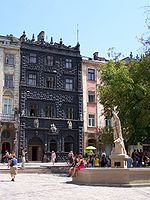
- Number 2. Bandinelli PalaceBandinelli PalacePalazzo Bandinelli is a late Renaissance townhouse facing Market Square in Lviv, Ukraine. It was built in 1589 by a pharmacist Jarosz Wedelski, and in 1634 it was bought by a Florentine merchant, Roberto Bandinelli, known as the founder of the first post office in eastern Galicia...
. Built in late Renaissance style in 1593. It was the property of Roberto Bandinelli from FlorenceFlorenceFlorence is the capital city of the Italian region of Tuscany and of the province of Florence. It is the most populous city in Tuscany, with approximately 370,000 inhabitants, expanding to over 1.5 million in the metropolitan area....
, the person who founded first mail office in Lviv in 1629. Remodelled in 1737–1739, after World War II it was in ruins. Recently renovated. Among persons who lived here, there was a Polish poet Kornel UjejskiKornel UjejskiKornel Ujejski , also known as Cornelius Ujejski, was a Polish poet, patriot and political writer.He was named "last of the greatest Polish poets of Romanticism"....
. - Number 3. House of the Wilczek Family. A RococoRococoRococo , also referred to as "Late Baroque", is an 18th-century style which developed as Baroque artists gave up their symmetry and became increasingly ornate, florid, and playful...
-style house, remodeled between 1771 and 1772. It owes its name to first owners. - Number 4. Black House. One of the most famous buildings of the square and one of the most beautiful examples of renaissance architectureRenaissance architectureRenaissance architecture is the architecture of the period between the early 15th and early 17th centuries in different regions of Europe, demonstrating a conscious revival and development of certain elements of ancient Greek and Roman thought and material culture. Stylistically, Renaissance...
in Lviv. It was built at the end of the 16th century for Italian tax-collector Tomas Alberti. The front elevation of the house is created from sandstone, which darkened through the years, making it architecturally significant. Since 1926 it has been part of the Historic City Museum. - Number 5. House of Lukasiewicz. Built in the 16th century by Piotr Krasowski.
- Number 6. King John III Sobieski Palace, also called Little WawelWawelWawel is an architectural complex erected over many centuries atop a limestone outcrop on the left bank of the Vistula River in Kraków, Poland, at an altitude of 228 metres above the sea level. It is a place of great significance to the Polish people. The Royal Castle with an armoury and the...
. It was originally built in 1580, for a Greek merchant Konstanty Korniakt, hence it is sometimes called The Palace of the Korniakts. In 1640, it was purchased by Jakub SobieskiJakub SobieskiJakub Sobieski was a Polish-Lithuanian noble, parliamentarian, diarist, political activist, military leader and father of King Jan III Sobieski. Son of castellan and voivode Marek Sobieski and Jadwiga Snopkowska.- Life :...
and inherited by King John III SobieskiJohn III SobieskiJohn III Sobieski was one of the most notable monarchs of the Polish–Lithuanian Commonwealth, from 1674 until his death King of Poland and Grand Duke of Lithuania. Sobieski's 22-year-reign was marked by a period of the Commonwealth's stabilization, much needed after the turmoil of the Deluge and...
. The Polish-Lithuanian ruler remodelled it into a palace-style residence, with spacious rooms and an audience hall. Sobieski’s house is made of two earlier, Gothic buildings joined together. Since 1908, a historical museum of the city has been located here. It is now part of the Lviv History Museum, with the Royal Chambers. They preserve and exhibit historical valuables: 18th-century furniture and clocks, silver artefacts, a collection of decorations, medals, and other items. Apart from Sobieski, another Polish king stayed here, Wladyslaw IV VasaWladyslaw IV VasaWładysław IV Vasa was a Polish and Swedish prince from the House of Vasa. He reigned as King of the Polish–Lithuanian Commonwealth from 8 November 1632 to his death in 1648....
, who in 1634 got smallpox and recovered here. - Number 7. House of Szembek. In the nicheNiche (architecture)A niche in classical architecture is an exedra or an apse that has been reduced in size, retaining the half-dome heading usual for an apse. Nero's Domus Aurea was the first semi-private dwelling that possessed rooms that were given richly varied floor plans, shaped with niches and exedras;...
, there is a 16th/17th century figure of Maria. - Number 8. House of Bernatowicz, with an Empire style facade.
- Number 9. Archbishop’s Palace. It was property of Lviv Roman Catholic Archbishops. Among its guests, there were several Polish kings and nobles. In 1634 it was thoroughly remodelled by Archbishop Stanislaw Grochowski. Here, on 10 November 1673, died King Michael Korybut Wisniowiecki. In 1845, a second floor was added and the house was turned into a condominium. Polish kings Sigismund III VasaSigismund III VasaSigismund III Vasa was King of Poland and Grand Duke of Lithuania, a monarch of the united Polish–Lithuanian Commonwealth from 1587 to 1632, and King of Sweden from 1592 until he was deposed in 1599...
and his son Wladyslaw IV stayed here while in Lviv. - Number 10. Lubomirski PalaceLubomirski Palace, LvivThe Lviv palace of Prince Stanisław Lubomirski was built in the 1760s to Jan de Witte's design on the site of several older houses . The palace's main façade, featuring decoration by Sebastian Vessinger, is on the Market Square...
or House of Prosvita. RococoRococoRococo , also referred to as "Late Baroque", is an 18th-century style which developed as Baroque artists gave up their symmetry and became increasingly ornate, florid, and playful...
style, created in 1763 by architect Jan de Witte, for Stanislaw LubomirskiStanislaw LubomirskiStanisław Lubomirski is the name of:* Stanisław Lubomirski , Polish nobleman* Stanisław Lubomirski , Polish-Lithuanian nobleman* Stanisław Lubomirski , Polish noble and magnate...
, out of two previously existing buildings. Between 1771 and 1821, it was seat of Austrian governors of GaliciaKingdom of Galicia and LodomeriaThe Kingdom of Galicia and Lodomeria was a crownland of the Habsburg Monarchy, the Austrian Empire, and Austria–Hungary from 1772 to 1918 .This historical region in eastern Central Europe is currently divided between Poland and Ukraine...
. In the mid-19th century, it was purchased by a Ukrainian organization, ProsvitaProsvitaProsvita is a society created in the nineteenth century in Ukrainian Galicia for preserving and developing Ukrainian culture and education among population....
. Here, on 30 June 1941, Yaroslav StetskoYaroslav StetskoYaroslav Stetsko was the leader of the Bandera's Organization of Ukrainian Nationalists , from 1968 until death. In 1941, during Nazi Germany invasion into the Soviet Union he was self-proclaimed temporary head of the self-proclaimed Ukrainian statehood...
proclaimed Ukraine's independence. Currently, there is an exposition of china in the palace.
Southern side
- Number 11. A 19th century house, build on the site of an earlier one.
- Number 12. Justglac House, with mascaronsMascaron (architecture)In architecture, a mascaron ornament is a face, usually human, sometimes frightening or chimeric whose function was originally to frighten away evil spirits so that they would not enter the building. The concept was subsequently adapted to become a purely decorative element. The most recent...
presenting faces of the SarmatiansSarmatiansThe Iron Age Sarmatians were an Iranian people in Classical Antiquity, flourishing from about the 5th century BC to the 4th century AD....
in the attic (see: SarmatismSarmatism"Sarmatism" is a term designating the dominant lifestyle, culture and ideology of the szlachta of the Polish-Lithuanian Commonwealth from the 16th to the 19th centuries. Together with "Golden Liberty," it formed a central aspect of the Commonwealth's culture...
). - Number 13
- Number 14. Venetian House. A Renaissance-style, remodelled by Pawel Rzymianin for a consul of VeniceVeniceVenice is a city in northern Italy which is renowned for the beauty of its setting, its architecture and its artworks. It is the capital of the Veneto region...
, Antonio Massari. On the front wall, there is a stone lion of Mark the EvangelistMark the EvangelistMark the Evangelist is the traditional author of the Gospel of Mark. He is one of the Seventy Disciples of Christ, and the founder of the Church of Alexandria, one of the original four main sees of Christianity....
, a coat of arms of Republic of VeniceRepublic of VeniceThe Republic of Venice or Venetian Republic was a state originating from the city of Venice in Northeastern Italy. It existed for over a millennium, from the late 7th century until 1797. It was formally known as the Most Serene Republic of Venice and is often referred to as La Serenissima, in...
and the date 1600. - Number 15
- Number 16. Mieszkowski House. Rococo style, with a Gothic portal.
- Number 17. Wening House. Rococo style, with main office of the Association of Polish Culture of the Lviv LandAssociation of Polish Culture of the Lviv LandAssociation of the Polish Culture of the Lviv Land is a Polish minority association, active in Lviv Oblast of western Ukraine. It was founded on December 3, 1989 in Lviv and its first director was Professor Leszek Mazepa...
located here. - Nr 18. Gutterer House, also called Pharmacy under the Golden Deer. Rococo style, built in 1533 and remodelled in 1785. It used to be called the prettiest tenement house in the city.
- Number 19
- Number 20. House Under the Lion
- Number 21. House of the Ubaldinis. Built in the 16th century, it belonged to a rich émigré from FlorenceFlorenceFlorence is the capital city of the Italian region of Tuscany and of the province of Florence. It is the most populous city in Tuscany, with approximately 370,000 inhabitants, expanding to over 1.5 million in the metropolitan area....
, Ripo Ubaldini. Among persons who lived here, there is Jerzy Michotek, who wrote a popular song, Only in Lwow.
Number 22. A 19th century house, built on the site of an earlier one.
Western side
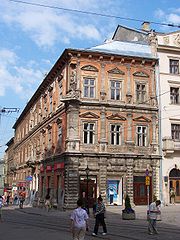
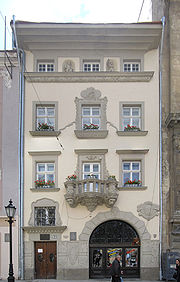
- Number 23. Scholz-Wolf House. Renaissance style, built in 1570 for the Scholz-Wolf family, which came to Lviv from SilesiaSilesiaSilesia is a historical region of Central Europe located mostly in Poland, with smaller parts also in the Czech Republic, and Germany.Silesia is rich in mineral and natural resources, and includes several important industrial areas. Silesia's largest city and historical capital is Wrocław...
. It is richly decorated; on the second floor there is a sculpture Baptism of Christ, probably by Herman von Hutte or Sebastian Czeszko. In this house, among others, lived a renowned 17th century Polish poet, Szymon SzymonowicSzymon SzymonowicSzymon Szymonowic was a Polish Renaissance poet. He was known as "the Polish Pindar."-Life:Szymonowic studied in Poland , France and Belgium...
. - Number 24. House of Giebl. Renaissance style, remodelled in 1920 in a modernistic style. Here, in 1707, stayed RussiaRussiaRussia or , officially known as both Russia and the Russian Federation , is a country in northern Eurasia. It is a federal semi-presidential republic, comprising 83 federal subjects...
n tsarTsarTsar is a title used to designate certain European Slavic monarchs or supreme rulers. As a system of government in the Tsardom of Russia and Russian Empire, it is known as Tsarist autocracy, or Tsarism...
Peter the Great. - Number 25. In the interbellum period, a Milikowski bookstore was located in this Rococo house.
- Number 26
- Number 27
- Number 28. Heppner House. Renaissance, built in 1510. It belonged to a doctor and member of the city council, Pawel Heppner. The house is known for its numerous lions, with as many as 20 of them.
- Number 29. The Palace of Felicjan Korytkowski, together with Andreolli’s covered way. Empire style, built on the site of the House of Zimorowicz, demolished in 1790.
- Number 30. House of Jakub Regula. Rococo-style.
- Number 31. Mazanczow House. Built in 1714 in a late Renaissance style, it belonged to the Baczewski family before the First and Second World War. The store that sold J. A. BaczewskiJ. A. BaczewskiJ. A. Baczewski was a Polish company most well-known for its fine spirits such as vodka and gin. The factory, dating back to late 18th century, was based in Lwów and until 1939 was one of two most popular Polish export goods.- History :...
spirits was located on the ground floor. Its art-deco façade was designed in the 1920s by architect Bronislaw Wiktor, the sculptural work is by Sigmund Kurczynski. - Number 32. Zipper Family House . A fusion of Modernism and Polish Renaissance, built in 1923 on the site of an earlier house.
Northern side
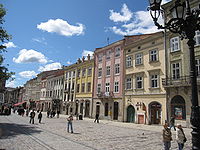
- Number 33
- Number 34
- Number 35
- Number 36. House of the Gielazyns. Built in 1778. Among its residents, there is Prince Jozef Poniatowski, who lived here in 1784-1785.
- Number 37. House of Marcin Gronswajer. Gronswajer was mayor of the city during the Khmelnytsky UprisingKhmelnytsky UprisingThe Khmelnytsky Uprising, was a Cossack rebellion in the Ukraine between the years 1648–1657 which turned into a Ukrainian war of liberation from Poland...
. - Number 38
- Number 39. Formerly a mint.
- Number 40. Boim Family House. Remodelled in late Baroque style in 1771.
- Number 41 Rococo style.
- Number 42
- Number 43
- Number 44
- Number 45. Under the Deer. Built in 1790. In the interbellum period, a popular Atlas Coffehouse was located here. It was a meeting place of local artists, such as Marian HemarMarian HemarMarian Hemar , born Jan Maria Hescheles, also Jan Mariański , Marian Wallenrod, was a Polish Jewish poet, journalist, playwright, comedy writer, and songwriter: he himself said that before the outbreak of World War II he had written 1200 songs including hits like Może kiedyś innym razem and Upić...
, Bruno SchulzBruno SchulzBruno Schulz was a Polish writer, fine artist, literary critic and art teacher born to Jewish parents, and regarded as one of the great Polish-language prose stylists of the 20th century. Schulz was born in Drohobycz, in the province of Galicia then part of the Austro-Hungarian Empire, and spent...
, Jan KasprowiczJan KasprowiczJan Kasprowicz was a poet, playwright, critic and translator; a foremost representative of Young Poland.-Life:...
and Jozef Wittlin. Here, in 1924, Adam HanuszkiewiczAdam HanuszkiewiczAdam Hanuszkiewicz is a Polish actor and theatre director.-External links:* http://www.culture.pl/pl/culture/artykuly/os_hanuszkiewicz_adam...
was born.

